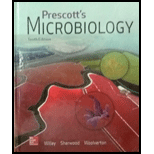
Prescott's Microbiology
10th Edition
ISBN: 9781259281594
Author: Joanne Willey, Linda Sherwood Adjunt Professor Lecturer, Christopher J. Woolverton Professor
Publisher: McGraw-Hill Education
expand_more
expand_more
format_list_bulleted
Concept explainers
Textbook Question
Chapter 34, Problem 2CHI
What other
Expert Solution & Answer
Want to see the full answer?
Check out a sample textbook solution
Students have asked these similar questions
Generate one question that requires a Punnet Squre to solve the question. Then show how you calculate the possibilities of genotype and phenotype
Briefly state the physical meaning of the electrocapillary equation (Lippman equation).
Explain in a small summary how:
What genetic information can be obtained from a Punnet square? What genetic information cannot be determined from a Punnet square?
Why might a Punnet Square be beneficial to understanding genetics/inheritance?
Chapter 34 Solutions
Prescott's Microbiology
Ch. 34.2 - What does the term valence mean and how does an...Ch. 34.2 - Distinguish between self and nonself substances.Ch. 34.2 - Prob. 2RIACh. 34.2 - How does a hapten differ from an antigen?Ch. 34.3 - What are the types of adaptive immunity?Ch. 34.3 - What distinguishes natural from artificial...Ch. 34.3 - What are ways that active immunity is different...Ch. 34.3 - Of the four types of acquired immunity, which do...Ch. 34.4 - On what types of cells are MHC class I molecules...Ch. 34.4 - Prob. 2MI
Ch. 34.4 - What are MHCs and HLAs? Describe the roles of the...Ch. 34.4 - Prob. 2RIACh. 34.4 - Prob. 3RIACh. 34.4 - How are foreign peptides processed so as to...Ch. 34.5 - Prob. 1MICh. 34.5 - Prob. 1RIACh. 34.5 - Prob. 2RIACh. 34.5 - Describe antigen processing. How does this process...Ch. 34.5 - Prob. 4RIACh. 34.5 - Prob. 5RIACh. 34.5 - Prob. 6RIACh. 34.6 - Which cells are functioning as APCs in this...Ch. 34.6 - Prob. 1RIACh. 34.6 - Briefly compare and contrast B cells and T cells...Ch. 34.6 - Prob. 3RIACh. 34.6 - Prob. 4RIACh. 34.7 - Prob. 1MICh. 34.7 - Prob. 2MICh. 34.7 - Prob. 3MICh. 34.7 - Prob. 1.1RIACh. 34.7 - Prob. 1.2RIACh. 34.7 - Prob. 1.3RIACh. 34.7 - Prob. 1.4RIACh. 34.7 - Prob. 2.1RIACh. 34.7 - Prob. 2.2RIACh. 34.7 - Prob. 2.3RIACh. 34.7 - Prob. 2.4RIACh. 34.7 - Prob. 2.5RIACh. 34.7 - Prob. 3.1RIACh. 34.7 - Prob. 3.2RIACh. 34.7 - In addition to combinatorial joining, what other...Ch. 34.8 - What is the difference between a precipitation and...Ch. 34.8 - Prob. 1RIACh. 34.8 - Prob. 2RIACh. 34.8 - How does opsonization inhibit microbial adherence...Ch. 34.8 - Prob. 4RIACh. 34.9 - Prob. 1RIACh. 34.9 - How would you define anergy?Ch. 34.10 - Prob. 1MICh. 34.10 - Prob. 2MICh. 34.10 - Prob. 1.1RIACh. 34.10 - Prob. 1.2RIACh. 34.10 - Prob. 1.3RIACh. 34.10 - Prob. 1.4RIACh. 34.10 - Prob. 1.5RIACh. 34.10 - What is an autoimmune disease and how might it...Ch. 34.10 - Prob. 2.2RIACh. 34.10 - Prob. 2.3RIACh. 34.10 - Prob. 2.4RIACh. 34 - What properties of proteins make them suitable...Ch. 34 - What other biotechnologies could be invented based...Ch. 34 - Speculate as to how MHC, TCR, and BCR molecules...Ch. 34 - Prob. 4CHICh. 34 - Prob. 5CHICh. 34 - In an effort to better understand the mechanisms...Ch. 34 - Prob. 7CHI
Knowledge Booster
Learn more about
Need a deep-dive on the concept behind this application? Look no further. Learn more about this topic, biology and related others by exploring similar questions and additional content below.Similar questions
- In a small summary write down:arrow_forwardNot part of a graded assignment, from a past midtermarrow_forwardNoggin mutation: The mouse, one of the phenotypic consequences of Noggin mutationis mispatterning of the spinal cord, in the posterior region of the mouse embryo, suchthat in the hindlimb region the more ventral fates are lost, and the dorsal Pax3 domain isexpanded. (this experiment is not in the lectures).a. Hypothesis for why: What would be your hypothesis for why the ventral fatesare lost and dorsal fates expanded? Include in your answer the words notochord,BMP, SHH and either (or both of) surface ectoderm or lateral plate mesodermarrow_forward
arrow_back_ios
SEE MORE QUESTIONS
arrow_forward_ios
Recommended textbooks for you
 Human Heredity: Principles and Issues (MindTap Co...BiologyISBN:9781305251052Author:Michael CummingsPublisher:Cengage Learning
Human Heredity: Principles and Issues (MindTap Co...BiologyISBN:9781305251052Author:Michael CummingsPublisher:Cengage Learning Comprehensive Medical Assisting: Administrative a...NursingISBN:9781305964792Author:Wilburta Q. Lindh, Carol D. Tamparo, Barbara M. Dahl, Julie Morris, Cindy CorreaPublisher:Cengage LearningEssentials of Pharmacology for Health ProfessionsNursingISBN:9781305441620Author:WOODROWPublisher:Cengage
Comprehensive Medical Assisting: Administrative a...NursingISBN:9781305964792Author:Wilburta Q. Lindh, Carol D. Tamparo, Barbara M. Dahl, Julie Morris, Cindy CorreaPublisher:Cengage LearningEssentials of Pharmacology for Health ProfessionsNursingISBN:9781305441620Author:WOODROWPublisher:Cengage


Human Heredity: Principles and Issues (MindTap Co...
Biology
ISBN:9781305251052
Author:Michael Cummings
Publisher:Cengage Learning


Comprehensive Medical Assisting: Administrative a...
Nursing
ISBN:9781305964792
Author:Wilburta Q. Lindh, Carol D. Tamparo, Barbara M. Dahl, Julie Morris, Cindy Correa
Publisher:Cengage Learning


Essentials of Pharmacology for Health Professions
Nursing
ISBN:9781305441620
Author:WOODROW
Publisher:Cengage
An Introduction to the Human Genome | HMX Genetics; Author: Harvard University;https://www.youtube.com/watch?v=jEJp7B6u_dY;License: Standard Youtube License